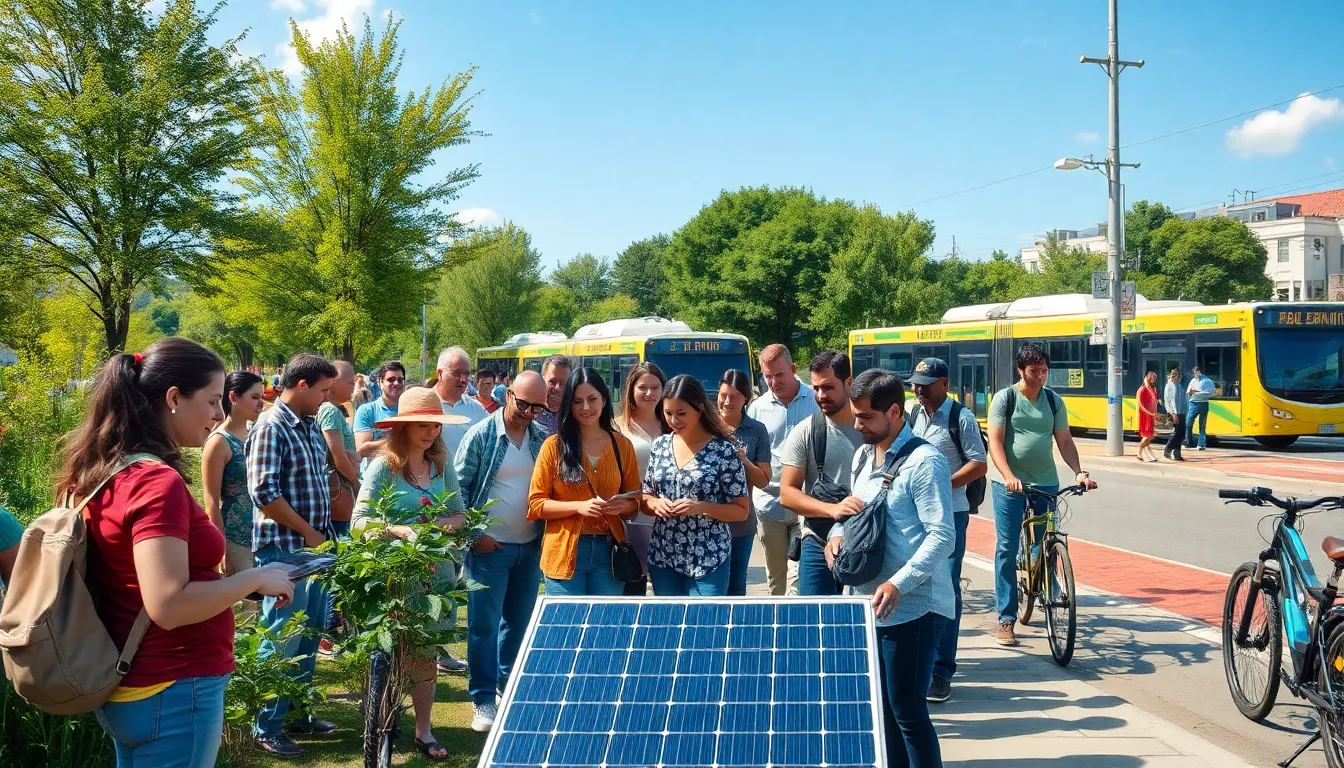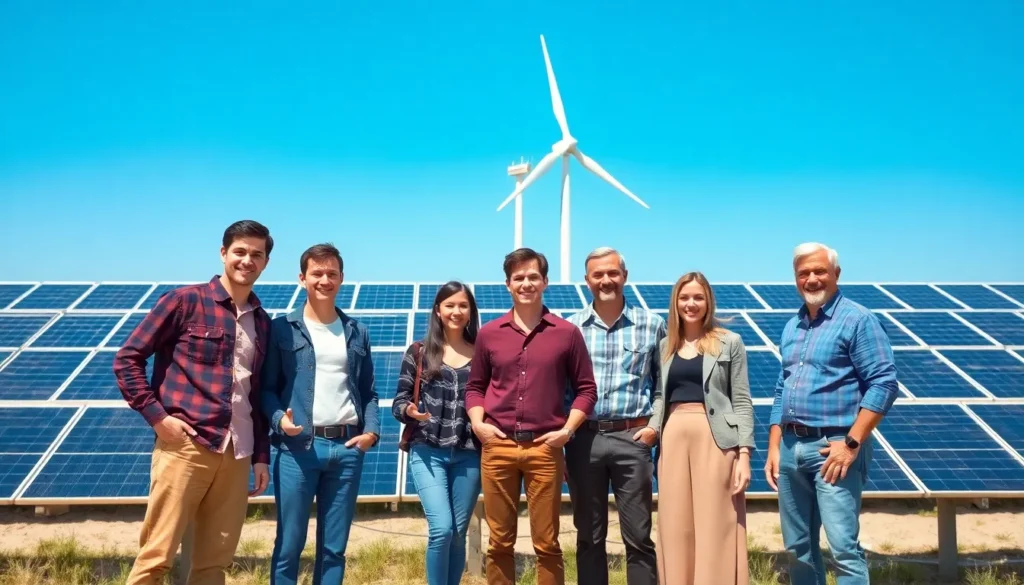Table of Contents
ToggleAs the world grapples with climate change, the push for low-carbon alternatives has never been more crucial. These innovative solutions aim to reduce greenhouse gas emissions while still meeting society’s energy and resource needs. From renewable energy sources like solar and wind to sustainable transportation options, the transition to a low-carbon economy is gaining momentum.
Exploring low-carbon alternatives not only helps combat environmental challenges but also opens doors to new technologies and economic opportunities. By embracing these alternatives, individuals and businesses can contribute to a healthier planet while enjoying the benefits of cleaner, more efficient energy. In this article, the focus will be on various low-carbon options and their potential to reshape our future.
Overview of Low-Carbon Alternatives
Low-carbon alternatives represent crucial strategies aimed at reducing greenhouse gas emissions. These strategies include renewable energy sources, energy efficiency measures, and sustainable practices in various industries.
Renewable Energy Sources
Renewable energy sources play a vital role in the transition to a low-carbon economy. These sources include:
- Solar Energy: Harnesses sunlight using photovoltaic cells or solar thermal systems.
- Wind Energy: Utilizes wind turbines to convert kinetic energy into electricity.
- Hydropower: Generates electricity by using flowing water to turn turbines.
- Bioenergy: Produces energy from organic materials, including biomass and biogas.
Energy Efficiency
Energy efficiency focuses on reducing energy consumption while maintaining the same level of service. Key measures include:
- Improved Insulation: Enhances building designs to minimize heat loss.
- Energy-efficient Appliances: Utilizes products that consume less electricity.
- Smart Grids: Integrates advanced technologies to optimize energy distribution.
Sustainable Transportation
Sustainable transportation aims to reduce carbon footprints from travel. It includes:
- Public Transit Systems: Encourages the use of buses, subways, and trains to reduce individual car use.
- Electric Vehicles (EVs): Operates on electricity to minimize emissions compared to traditional gasoline models.
- Cycling Infrastructure: Develops bicycle lanes and facilities to promote cycling as a transport option.
Carbon Capture and Storage
Carbon capture and storage (CCS) technologies capture carbon dioxide emissions from sources like power plants. Key aspects include:
- Capture Techniques: Utilize methods to trap CO2 before reaching the atmosphere.
- Storage Solutions: Inject captured CO2 into underground geological formations for long-term containment.
Each low-carbon alternative contributes to a collective goal of mitigating climate change while supporting economic growth and innovative technologies. Adopting these solutions enhances energy security and promotes environmental sustainability.
Types of Low-Carbon Alternatives

Low-carbon alternatives play a significant role in mitigating climate change and facilitating sustainable development. Various options exist within this framework, focusing on renewable energy and sustainable transportation.
Renewable Energy Sources
Renewable energy sources include solar, wind, hydropower, and bioenergy.
- Solar energy harnesses sunlight for electricity and heating, utilizing photovoltaic cells and solar thermal systems. In 2022, solar energy accounted for 20% of global electricity generation.
- Wind energy generates power through turbines that convert wind movement into electricity. This source represented 9% of global electricity generation in 2022.
- Hydropower captures the energy of flowing water, translating it into electricity. Hydropower contributed approximately 16% of worldwide electricity production in 2022.
- Bioenergy uses organic matter, such as plant materials and waste, to produce heat, electricity, and biofuels. It accounted for about 5% of global energy consumption in 2021.
These renewable sources significantly reduce reliance on fossil fuels, lowering greenhouse gas emissions and enhancing energy security.
Sustainable Transportation Options
Sustainable transportation options reduce carbon footprints associated with travel.
- Public transit systems facilitate mass transportation, lowering per-person emissions compared to individual vehicles. Buses and trains often operate on cleaner energy sources.
- Electric vehicles (EVs) utilize electricity instead of fossil fuels, minimizing emissions during operation. The number of EVs on the road reached over 10 million globally in 2022, reducing greenhouse gas emissions considerably.
- Cycling infrastructure encourages biking as an eco-friendly alternative, leading to reduced vehicle emissions. Cities investing in dedicated bike lanes see increased cycling rates and improved air quality.
Implementing these sustainable options promotes cleaner air and contributes to lower overall carbon emissions in the transportation sector.
Benefits of Low-Carbon Alternatives
Low-carbon alternatives deliver multiple benefits that contribute significantly to environmental sustainability and economic growth.
Environmental Protection
Low-carbon alternatives significantly reduce greenhouse gas emissions. Transitioning to renewable energy sources, such as solar and wind, results in cleaner air and improved public health. For instance, solar energy alone has curtailed millions of tons of carbon dioxide emissions globally.
Energy Security
Low-carbon alternatives enhance energy security by decreasing reliance on fossil fuels. Countries that invest in renewable energy diversify their energy portfolios, making them less vulnerable to price fluctuations and supply disruptions. Renewable sources accounted for around 45% of new global electricity capacity installed in 2021.
Economic Growth
Low-carbon alternatives create economic opportunities through the development of green technologies. Investment in renewable energy sectors fosters job creation in areas such as manufacturing, installation, and maintenance. The International Renewable Energy Agency (IRENA) reported 11.5 million jobs in the renewable energy sector worldwide as of 2018, reflecting ongoing growth.
Technological Innovation
Low-carbon alternatives spur technological advancements, improving efficiency and reducing costs. Innovations in battery storage and smart grid technologies enhance the integration of renewable sources into the existing energy infrastructure. These developments enable more sustainable energy management and maximize resource optimization.
Social Benefits
Low-carbon alternatives contribute to social equity by providing accessible energy solutions. Community-based renewable projects can empower localized energy initiatives, improving livelihoods. Public transportation options, such as electric buses and trains, reduce congestion and improve mobility for underserved communities.
Resilience to Climate Change
Low-carbon alternatives increase resilience to climate change impacts. By transitioning to sustainable practices, communities can better adapt to extreme weather events and environmental changes. This approach fosters long-term sustainability and increases community well-being.
Through these benefits, low-carbon alternatives play a critical role in shaping a sustainable future, ensuring ecological balance and fostering economic resilience.
Challenges in Adoption of Low-Carbon Alternatives
Various challenges impede the widespread adoption of low-carbon alternatives. Addressing these obstacles is crucial for transitioning to a sustainable future.
- High Initial Costs
High initial costs of renewable energy technologies remain a significant barrier. Solar panels, wind turbines, and energy-efficient appliances often require substantial upfront investment, which can deter individuals and businesses from adopting these alternatives.
- Infrastructure Limitations
Infrastructure limitations restrict the scalability of low-carbon solutions. Existing energy grids may lack the capacity to integrate diverse renewable energy sources effectively. Upgrading and enhancing these infrastructures demands substantial resources and time.
- Policy and Regulatory Hurdles
Policy and regulatory hurdles present additional challenges in adoption. Inconsistent policies, lack of incentives, and bureaucratic delays often complicate investments in low-carbon technologies. Clear and cohesive policies are necessary to promote innovation in this sector.
- Public Awareness and Education
Public awareness and education play significant roles in adoption. Many people remain unaware of the advantages of low-carbon alternatives, leading to skepticism about their effectiveness. Increased educational initiatives can help inform the public and encourage acceptance.
- Technological Maturity
Technological maturity varies across different low-carbon alternatives. Some technologies, like solar and wind, have reached advanced stages of development, while others, such as hydrogen fuel cells, still require further research and investment to become viable options.
- Market Competition
Market competition poses a challenge to low-carbon alternatives. Fossil fuels often maintain lower prices due to established supply chains and subsidies. Without a level playing field, renewable energy sources struggle to gain market share, impacting investments.
- Behavioral and Cultural Factors
Behavioral and cultural factors impact adoption rates. Ingrained habits and resistance to change can hinder the acceptance of low-carbon alternatives in communities. Tailored outreach and community engagement strategies can address these issues effectively.
- Supply Chain Dependencies
Supply chain dependencies affect the availability of materials for low-carbon technologies. Constraints in sourcing critical components, like rare metals used in batteries, can slow down production and hinder market growth.
Focusing on these challenges is vital to facilitate the transition toward low-carbon solutions. Collaborative efforts among policymakers, industry leaders, and communities can drive progress in overcoming these barriers and fostering a sustainable future.
Future Trends in Low-Carbon Alternatives
Emerging technologies and evolving practices play a crucial role in shaping the future landscape of low-carbon alternatives. These trends drive significant changes in energy production, consumption, and environmental impact.
Increased Adoption of Renewable Energy
- Solar Power Innovations: Advancements in solar panel efficiency promise to enhance energy output, lowering installation costs and making solar a more feasible option for residential and commercial use.
- Wind Energy Expansion: Innovations in turbine design and offshore wind farms increase energy generation capacity. The global trend favors larger and more efficient wind turbines for maximizing output.
- Hydropower Modernization: New technologies improve hydropower systems, enabling better management of water resources while minimizing ecological disruption.
Advancements in Energy Storage
- Battery Technology Improvements: Innovations in lithium-ion and solid-state batteries enhance energy storage capacity, addressing intermittency issues in renewable energy generation.
- Grid-Scale Storage Solutions: Large-scale storage options, such as pumped hydro and advanced battery systems, support grid stability and integrate more renewable energy sources.
Sustainable Transportation Innovations
- Electrification of Public Transport: Buses and trains are increasingly electrifying, significantly reducing urban emissions and improving air quality.
- Development of Alternative Fuels: Biofuels and hydrogen technologies are advancing, providing cleaner options for heavy-duty vehicles and aviation.
- Mobility-as-a-Service (MaaS): Integrated mobility solutions promote public transit and shared transportation options, reducing reliance on personal vehicles and emissions.
Carbon Management Strategies
- Enhanced Carbon Capture and Storage (CCS): Ongoing developments in CCS technology improve efficiency and cost-effectiveness, enabling more facilities to adopt these solutions.
- Carbon Utilization Technologies: Innovative methods capture CO2 emissions and convert them into useful products, such as fuels and materials, fostering a circular economy model.
Policy and Regulatory Frameworks
- Strengthened Policies for Renewable Energy: Governments worldwide are implementing policies, incentives, and regulations to support renewable energy investments and phase out fossil fuels.
- Global Climate Agreements: International cooperation under frameworks like the Paris Agreement encourages nations to commit to low-carbon targets and share best practices.
Emerging trends in low-carbon alternatives reflect a collective commitment to sustainable practices, balancing economic development with environmental stewardship. Implementing these innovations matters for achieving a low-carbon future.
Embracing low-carbon alternatives is essential for a sustainable future. These solutions not only address pressing environmental challenges but also pave the way for economic growth and technological innovation. By investing in renewable energy and sustainable practices, society can significantly reduce greenhouse gas emissions and enhance energy security.
The transition to a low-carbon economy requires collective action from policymakers, industries, and communities. Overcoming the barriers to adoption will unlock the potential of emerging technologies and practices. As the world moves forward, the commitment to low-carbon alternatives will be crucial in shaping a resilient and equitable future for generations to come.







